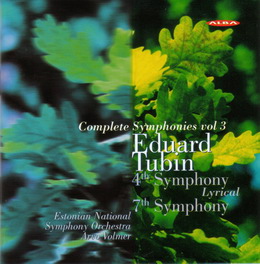< Plaadid
EDUARD TUBIN sümfooniad nr 4 ja 7. Alba Records 2001

Alba Records 2001
Eesti Riiklik Sümfooniaorkester
Dirigent ARVO VOLMER
Eduard Tubin (1905–1982)
Complete Symphonies vol. 3
Sümfoonia nr 4 (“Lüüriline”)
Sümfoonia nr 7
ARVUSTUSED
David Hurwitz. Classics Today
Neeme Järvi’s BIS recording of Tubin’s glorious Fourth Symphony, taken from an indifferently played and distantly recorded live concert in Bergen, Norway, represented the Achilles heel of his otherwise excellent complete cycle. This splendid new version thus fills a major gap in the Tubin discography. Interestingly enough, the piece bears a striking resemblance (conceptually, if not thematically) to the Fifth Symphony of Vaughan Williams, a work Tubin could not have known as both symphonies were completed in exactly the same year (1943), in the midst of World War II.
Like the Vaughan Williams, Tubin’s Fourth explores his own personal brand of lyricism to its utmost limits in music of extraordinary surface beauty and spiritual depth. Arno Volmer and the Estonian National Symphony Orchestra play it with genuine passion and impressive technical accomplishment. The strings, in particular, have the purity of tone and luminous quality that this music demands, and the entry of the harp in the slow movement adds a special touch of poetry and raptness of expression that’s quite unforgettable. If you don’t know this extraordinary work and you relish the Vaughan Williams, or say, Sibelius’ Sixth, you really must give Tubin a listen.
By the time he came to write his Seventh Symphony in 1958, Tubin had been living in exile in Sweden for more than a decade. Like the Fourth, the Seventh uses a traditional-sized orchestra albeit with even fewer “extras” (no harp, and timpani only in the finale). The style may be more acerbic, rather like Honegger in its characterful use of spiky dissonance and in its increasingly contrapuntal demeanor, but those bittersweet melodies moving over a narrow range, married to an orchestral sonority focused on the ensemble’s middle register, mark the work as pure Tubin. Järvi’s recording of this symphony is excellent, but then so is this newcomer. Volmer’s slightly broader tempos in the outer movements give the composer’s tangy harmony more time to bite, and the Estonians bring a greater sense of terror to the march-like finale’s emphatic closing bars. It’s great in any case to have a different, equally valid view, with playing and sound that in every way match the superlative standard of the BIS recording. Fabulous!